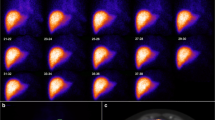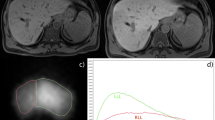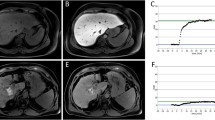Abstract
Objective
To investigate if tracer kinetic modelling of low temporal resolution dynamic contrast-enhanced (DCE) MRI with Gd-EOB-DTPA could replace technetium-99 m galactosyl human serum albumin (GSA) single positron emission computed tomography (SPECT) and indocyanine green (ICG) retention for the measurement of liver functional reserve.
Methods
Twenty eight patients awaiting liver resection for various cancers were included in this retrospective study that was approved by the institutional review board. The Gd-EOB-DTPA MRI sequence acquired five images: unenhanced, double arterial phase, portal phase, and 4 min after injection. Intracellular contrast uptake rate (UR) and extracellular volume (Ve) were calculated from DCE-MRI, along with the ratio of GSA radioactivity of liver to heart-plus-liver and per cent of cumulative uptake from 15–16 min (LHL15 and LU15, respectively) from GSA-scintigraphy. ICG retention at 15 min, Child–Pugh cirrhosis score (CPS) and postoperative Inuyama fibrosis criteria were also recorded. Statistical analysis was with Spearman rank correlation analysis.
Results
Comparing MRI parameters with the reference methods, significant correlations were obtained for UR and LHL15, LU15, ICG15 (all 0.4–0.6, P < 0.05); UR and CPS (-0.64, P < 0.001); Ve and Inuyama (0.44, P < 0.05).
Conclusion
Measures of liver function obtained by routine Gd-EOB-DTPA DCE-MRI with tracer kinetic modelling may provide a suitable method for the evaluation of liver functional reserve.
Key points
• Magnetic resonance imaging (MRI) provides new methods of measuring hepatic functional reserve.
• DCE-MRI with Gd-EOB-DTPA offers the possibility of replacing scintigraphy.
• The analysis method can be used for preoperative liver function evaluation.



Similar content being viewed by others
References
Lau H, Man K, Fan ST, Yu WC, Lo CM, Wong J (1997) Evaluation of preoperative hepatic function in patients with hepatocellular carcinoma undergoing hepatectomy. Br J Surg 84:1255–1259
Manizate F, Hiotis SP, Labow D, Roayaie S, Schwartz M (2010) Liver functional reserve estimation: state of the art and relevance for local treatments: the Western perspective. J Hepatobiliary Pancreat Sci 17:385–388
Kamath PS, Wiesner RH, Malinchoc M et al (2001) A model to predict survival in patients with end-stage liver disease. Hepatology 33:464–470
Stadalnik RC, Vera DR, Woodle ES et al (1985) Technetium-99m NGA functional hepatic imaging: preliminary clinical experience. J Nucl Med 26:1233–1242
Vera DR, Krohn KA, Scheibe PO, Stadalnik RC (1985) Identifiability analysis of an in vivo receptor-binding radiopharmacokinetic system. IEEE Trans Biomed Eng 32:312–322
Vera DR, Krohn KA, Stadalnik RC, Scheibe PO (1984) Tc-99m-galactosyl-neoglycoalbumin: in vivo characterization of receptor-mediated binding to hepatocytes. Radiology 151:191–196
Vera DR, Krohn KA, Stadalnik RC, Scheibe PO (1984) Tc-99m galactosyl-neoglycoalbumin: in vitro characterization of receptor-mediated binding. J Nucl Med 25:779–787
Vera DR, Stadalnik RC, Krohn KA (1985) Technetium-99m galactosyl-neoglycoalbumin: preparation and preclinical studies. J Nucl Med 26:1157–1167
Annet L, Materne R, Danse E, Jamart J, Horsmans Y, Van Beers BE (2003) Hepatic flow parameters measured with MR imaging and Doppler US: correlations with degree of cirrhosis and portal hypertension. Radiology 229:409–414
Baxter S, Wang ZJ, Joe BN, Qayyum A, Taouli B, Yeh BM (2009) Timing bolus dynamic contrast-enhanced (DCE) MRI assessment of hepatic perfusion: initial experience. J Magn Reson Imaging 29:1317–1322
Blomley MJ, Coulden R, Dawson P et al (1995) Liver perfusion studied with ultrafast CT. J Comput Assist Tomogr 19:424–433
Hagiwara M, Rusinek H, Lee VS et al (2008) Advanced liver fibrosis: diagnosis with 3D whole-liver perfusion MR imaging–initial experience. Radiology 246:926–934
Koh TS, Thng CH, Hartono S et al (2009) Dynamic contrast-enhanced CT imaging of hepatocellular carcinoma in cirrhosis: feasibility of a prolonged dual-phase imaging protocol with tracer kinetics modeling. Eur Radiol 19:1184–1196
Miles KA, Hayball MP, Dixon AK (1993) Functional images of hepatic perfusion obtained with dynamic CT. Radiology 188:405–411
Ryeom HK, Kim SH, Kim JY et al (2004) Quantitative evaluation of liver function with MRI using Gd-EOB-DTPA. Korean J Radiol 5:231–239
Thng CH, Koh TS, Collins DJ, Koh DM (2010) Perfusion magnetic resonance imaging of the liver. World J Gastroenterol 16:1598–1609
Van Beers BE, Leconte I, Materne R, Smith AM, Jamart J, Horsmans Y (2001) Hepatic perfusion parameters in chronic liver disease: dynamic CT measurements correlated with disease severity. AJR Am J Roentgenol 176:667–673
Godfrey EM, Mannelli L, Griffin N, Lomas DJ (2013) Magnetic resonance elastography in the diagnosis of hepatic fibrosis. Semin Ultrasound CT MR 34:81–88
Herold C, Reck T, Fischler P et al (2002) Prognosis of a large cohort of patients with hepatocellular carcinoma in a single European centre. Liver 22:23–28
Nagasue N, Kohno H, Chang YC et al (1993) Liver resection for hepatocellular carcinoma. Results of 229 consecutive patients during 11 years. Ann Surg 217:375–384
Okamoto E, Kyo A, Yamanaka N, Tanaka N, Kuwata K (1984) Prediction of the safe limits of hepatectomy by combined volumetric and functional measurements in patients with impaired hepatic function. Surgery 95:586–592
Truant S, Oberlin O, Sergent G et al (2007) Remnant liver volume to body weight ratio > or =0.5 %: a new cut-off to estimate postoperative risks after extended resection in noncirrhotic liver. J Am Coll Surg 204:22–33
Iimuro Y, Kashiwagi T, Yamanaka J et al (2010) Preoperative estimation of asialoglycoprotein receptor expression in the remnant liver from CT/99mTc-GSA SPECT fusion images correlates well with postoperative liver function parameters. J Hepatobiliary Pancreat Sci 17:673–681
Kaibori M, Ha-Kawa SK, Maehara M et al (2011) Usefulness of Tc-99m-GSA scintigraphy for liver surgery. Ann Nucl Med 25:593–602
Ashwell G, Morell AG (1974) The role of surface carbohydrates in the hepatic recognition and transport of circulating glycoproteins. Adv Enzymol Relat Areas Mol Biol 41:99–128
Kashiwagi T, Yutani K, Fukuchi M et al (2002) Correction of nonuniform attenuation and image fusion in SPECT imaging by means of separate X-ray CT. Ann Nucl Med 16:255–261
Ichikawa T, Saito K, Yoshioka N et al (2010) Detection and characterization of focal liver lesions: a Japanese phase III, multicenter comparison between gadoxetic acid disodium-enhanced magnetic resonance imaging and contrast-enhanced computed tomography predominantly in patients with hepatocellular carcinoma and chronic liver disease. Invest Radiol 45:133–141
Vogl TJ, Kummel S, Hammerstingl R et al (1996) Liver tumors: comparison of MR imaging with Gd-EOB-DTPA and Gd-DTPA. Radiology 200:59–67
Clement O, Siauve N, Lewin M, de Kerviler E, Cuenod CA, Frija G (1998) Contrast agents in magnetic resonance imaging of the liver: present and future. Biomed Pharmacother 52:51–58
Nilsson H, Nordell A, Vargas R, Douglas L, Jonas E, Blomqvist L (2009) Assessment of hepatic extraction fraction and input relative blood flow using dynamic hepatocyte-specific contrast-enhanced MRI. J Magn Reson Imaging 29:1323–1331
Saito K, Ledsam J, Sourbron S et al (2012) Assessing liver function using dynamic Gd-EOB-DTPA-enhanced MRI with a standard 5-phase imaging protocol. J Magn Reson Imaging 37:1109–1114
Sourbron S, Sommer WH, Reiser MF, Zech CJ (2012) Combined quantification of liver perfusion and function with dynamic gadoxetic acid-enhanced MR imaging. Radiology 263:874–883
Nilsson H, Blomqvist L, Douglas L, Nordell A, Jonas E (2010) Assessment of liver function in primary biliary cirrhosis using Gd-EOB-DTPA-enhanced liver MRI. HPB (Oxford) 12:567–576
Pugh RN, Murray-Lyon IM, Dawson JL, Pietroni MC, Williams R (1973) Transection of the oesophagus for bleeding oesophageal varices. Br J Surg 60:646–649
Ichida FTT, Omata M, Ichida T, Inoue K, Kamimura T, Yamada G, Hino K, Yokosuka O, Suzuki H (1996) New Inuyama classification; new criteria for histological assessment of chronic hepatitis. Int Hepatol Commun 6:112–119
Watanabe H, Kanematsu M, Goshima S et al (2011) Staging hepatic fibrosis: comparison of gadoxetate disodium-enhanced and diffusion-weighted MR imaging–preliminary observations. Radiology 259:142–150
Patlak CS, Blasberg RG, Fenstermacher JD (1983) Graphical evaluation of blood-to-brain transfer constants from multiple-time uptake data. J Cereb Blood Flow Metab 3:1–7
Pedersen M, Shi Y, Anderson P et al (2004) Quantitation of differential renal blood flow and renal function using dynamic contrast-enhanced MRI in rats. Magn Reson Med 51:510–517
Ha-Kawa SK, Tanaka Y, Hasebe S et al (1997) Compartmental analysis of asialoglycoprotein receptor scintigraphy for quantitative measurement of liver function: a multicentre study. Eur J Nucl Med 24:130–137
Koizumi K, Uchiyama G, Arai T, Ainoda T, Yoda Y (1992) A new liver functional study using Tc-99m DTPA-galactosyl human serum albumin: evaluation of the validity of several functional parameters. Ann Nucl Med 6:83–87
Makuuchi M, Kosuge T, Takayama T et al (1993) Surgery for small liver cancers. Semin Surg Oncol 9:298–304
Burgess JB, Baenziger JU, Brown WR (1992) Abnormal surface distribution of the human asialoglycoprotein receptor in cirrhosis. Hepatology 15:702–706
Hwang EH, Taki J, Shuke N et al (1999) Preoperative assessment of residual hepatic functional reserve using 99mTc-DTPA-galactosyl-human serum albumin dynamic SPECT. J Nucl Med 40:1644–1651
Kwon AH, Ha-Kawa SK, Uetsuji S, Inoue T, Matsui Y, Kamiyama Y (1997) Preoperative determination of the surgical procedure for hepatectomy using technetium-99m-galactosyl human serum albumin (99mTc-GSA) liver scintigraphy. Hepatology 25:426–429
Kwon AH, Matsui Y, Kaibori M, Ha-Kawa SK (2006) Preoperative regional maximal removal rate of technetium-99m-galactosyl human serum albumin (GSA-Rmax) is useful for judging the safety of hepatic resection. Surgery 140:379–386
Mastai R, Laganiere S, Wanless IR, Giroux L, Rocheleau B, Huet PM (1996) Hepatic sinusoidal fibrosis induced by cholesterol and stilbestrol in the rabbit: 2. Hemodynamic and drug disposition studies. Hepatology 24:865–870
Iguchi T, Sato S, Kouno Y et al (2003) Comparison of Tc-99m-GSA scintigraphy with hepatic fibrosis and regeneration in patients with hepatectomy. Ann Nucl Med 17:227–233
Van Beers BE, Materne R, Annet L et al (2003) Capillarization of the sinusoids in liver fibrosis: noninvasive assessment with contrast-enhanced MRI in the rabbit. Magn Reson Med 49:692–699
Nguyen-Khac E, Lobry C, Chatelain D et al (2013) A reappraisal of chemotherapy-induced liver injury in colorectal liver metastases before the era of antiangiogenics. Int J Hepatol 2013:314868
Shaib YH, El-Serag HB, Nooka AK et al (2007) Risk factors for intrahepatic and extrahepatic cholangiocarcinoma: a hospital-based case-control study. Am J Gastroenterol 102:1016–1021
Acknowledgements
This study was supported by the Great Britain Sasakawa Foundation.
Author information
Authors and Affiliations
Corresponding author
Rights and permissions
About this article
Cite this article
Saito, K., Ledsam, J., Sourbron, S. et al. Measuring hepatic functional reserve using low temporal resolution Gd-EOB-DTPA dynamic contrast-enhanced MRI: a preliminary study comparing galactosyl human serum albumin scintigraphy with indocyanine green retention. Eur Radiol 24, 112–119 (2014). https://doi.org/10.1007/s00330-013-2983-y
Received:
Revised:
Accepted:
Published:
Issue Date:
DOI: https://doi.org/10.1007/s00330-013-2983-y




